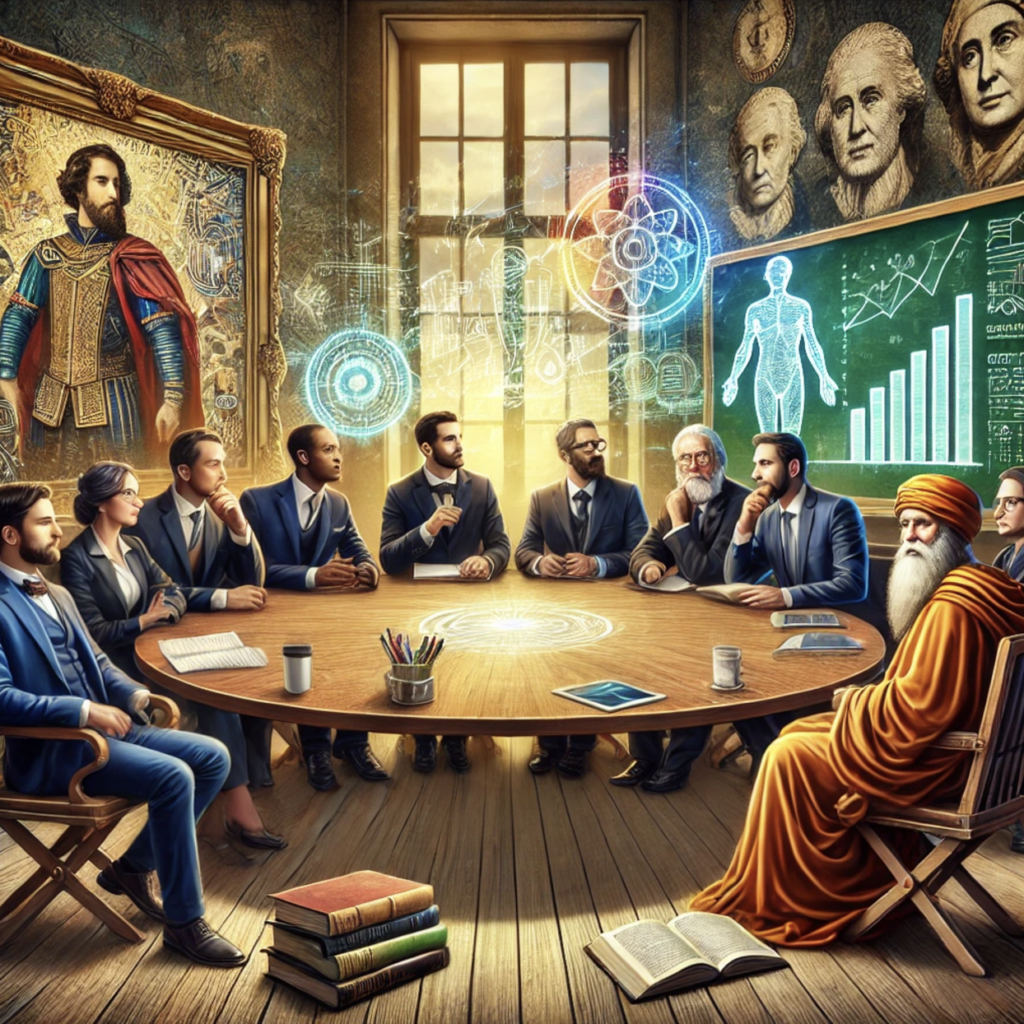In the archives of business history, there are some whose names have become synonymous with:
- Entrepreneurial genius
- Visionary leadership
- And unparalleled success.
From industry titans who revolutionized entire sectors to innovators who defied convention and reshaped the business landscape, the lessons imparted by these luminaries continue to inspire and inform aspiring entrepreneurs and seasoned professionals alike.
In this exploration, we delve into the lives and legacies of some of the greatest business minds in history, uncovering timeless principles and invaluable insights for achieving success in today’s dynamic and competitive world.
Andrew Carnegie: The Master of Industry
Born into humble beginnings in Scotland, Andrew Carnegie rose to prominence as one of the wealthiest and most influential industrialists of his time.
Through his leadership of Carnegie Steel Corporation, he transformed the steel industry and played a pivotal role in the expansion of American infrastructure.
Carnegie’s philosophy of:
- Vertical integration
- Strategic partnerships
- And relentless focus on efficiency
revolutionized the business world and laid the foundation for modern corporate management.
Lesson 1: Embrace Adaptation
Carnegie’s success was built on a willingness to adapt to changing market conditions.
By:
- Investing in new tech
- Streamlining production processes
- And anticipating industry trends
he stayed ahead of the curve and maintained a competitive edge in a rapidly evolving marketplace.
Today’s business leaders can learn from Carnegie’s example by:
- Fostering a culture of innovation
- Embracing emerging tech
- And continually adapting their strategies
to meet the demands of an ever-changing business landscape.
Lesson 2: Cultivate a Culture of Excellence
Central to Carnegie’s success was his unwavering commitment to excellence in all aspects of business operations.
From the quality of products to the treatment of employees, he set high standards and held himself and his company accountable for achieving them.
By fostering a culture of excellence and instilling a sense of pride and ownership among employees, Carnegie created a workforce that was:
- Highly motivated
- Productive
- And loyal
(A key factor in his company’s success).
Walt Disney: The Master of Imagination
As the creative genius behind the Disney empire, Walt Disney brought joy, laughter, and inspiration to millions of people around the world.
Through his:
- Pioneering work in animation
- Theme park design
- And entertainment production
he created a legacy that continues to captivate audiences of all ages.
Disney’s:
- Boundless imagination
- Entrepreneurial spirit
- And unwavering optimism
serve as a source of inspiration for dreamers and innovators across the globe.
Lesson 3: Dream Big and Never Give Up
Disney’s success was fueled by his ability to dream big and never give up in the face of adversity.
Despite numerous setbacks and failures early in his career, he remained steadfast in his pursuit of his vision, refusing to let obstacles deter him from achieving his goals.
By embracing failure as a necessary stepping stone to success and maintaining an unwavering belief in his dreams, Disney transformed his aspirations into reality and built an entertainment empire that continues to enchant and inspire generations.
Lesson 4: Create Magical Experiences
Central to Disney’s success was his relentless focus on creating magical experiences that captivated the imagination and touched the hearts of audiences.
Whether through:
- The enchanting world of Disneyland
- The timeless classics of Disney animation
- Or the immersive storytelling of Disney films
he sought to transport people to a realm of wonder and possibility.
By infusing every aspect of his work with:
- Creativity
- Innovation
- And attention to detail
Disney created experiences that transcended entertainment and became cherished memories for millions of people around the world.
Andy Warhol: The Artistic Innovator
Andy Warhol, the iconic figure of the Pop Art movement, revolutionized the world of contemporary art with his bold, unconventional approach to creativity.
Through his distinctive style, which blended elements of:
- Consumer culture
- Celebrity
- And mass media
Warhol challenged traditional notions of art and aesthetics, transforming everyday objects and images into works of profound cultural significance.
Lesson 5: Embrace Unconventional Thinking
By elevating ordinary objects and images to the realm of high art, he pushed the boundaries of artistic expression and redefined the concept of beauty.
Today’s business leaders can learn from Warhol’s example by:
- Daring to think outside the box
- Questioning established norms
- And embracing innovation and creativity
as drivers of success.
William Randolph Hearst: The Media Mogul
William Randolph Hearst, the pioneering media magnate, built a vast empire of:
- Newspapers
- Magazines
- And media outlets
that shaped public opinion and influenced the course of history.
Through his:
- Innovative journalism
- Sensationalist headlines
- And relentless pursuit of scoops
Hearst transformed the media landscape and set the stage for the modern era of mass communication.
Lesson 6: Harness the Power of Storytelling
Hearst’s success was built on his ability to harness the power of storytelling to capture the hearts and minds of audiences.
By leveraging:
- Compelling narratives
- Captivating headlines
- And dramatic imagery
he engaged readers and kept them coming back for more.
Today’s business leaders can learn from Hearst’s example by prioritizing storytelling as a powerful tool for:
- Building brand identity
- Connecting with customers
- And shaping public perception.
Ari Onassis: The Shipping Tycoon
Ari Onassis, the Greek shipping magnate, rose from humble beginnings to become one of the wealthiest and most influential businessmen of his time.
Through his:
- Shrewd business acumen
- Strategic alliances
- And relentless pursuit of opportunity
Onassis built a global shipping empire that dominated the seas and transformed the maritime industry.
Lesson 7: Seize Opportunity with Confidence
Onassis’s success was driven by his unwavering confidence in his ability to seize opportunity and turn it into profit.
Whether it was acquiring distressed shipping fleets during times of economic turmoil or forging strategic partnerships with governments and industry leaders, he approached every opportunity with boldness and determination.
Today’s business leaders can learn from Onassis’s example by:
- Cultivating a mindset of confidence
- Agility
- And opportunism
and being prepared to capitalize on emerging trends and market shifts.
Steve Jobs: The Visionary Innovator
Steve Jobs, the visionary co-founder of Apple Inc., revolutionized the world of technology with his:
- Pioneering products
- Visionary leadership
- And relentless pursuit of perfection.
Through his unwavering commitment to:
- Innovation
- Design excellence
- And user experience
Jobs transformed Apple into one of the most valuable and influential companies in the world.
Lesson 8: Focus on Design and User Experience
Jobs’s success was built on his unwavering commitment to design excellence and user experience.
Whether it was the sleek, minimalist aesthetics of Apple products or the intuitive functionality of the company’s software, he understood the importance of creating products that not only looked beautiful but also delighted users with their ease of use and functionality.
Today’s business leaders can learn from Jobs’s example by prioritizing design and user experience as essential elements of their products and services, and striving to create experiences that resonate with customers on an emotional level.
Sam Walton: The Retail Trailblazer
Sam Walton, the founder of Walmart, revolutionized the retail industry with his:
- Innovative business model
- Relentless focus on customer satisfaction
- And commitment to pricing.
Through his:
- Visionary leadership
- Strategic expansion
- And dedication to operational efficiency
Walton built Walmart into the world’s largest retailer, transforming the way people shop and live.
Lesson 9: Prioritize Customer Satisfaction
Walton’s success was built on his unwavering commitment to customer satisfaction.
He understood that by offering high-quality products at unbeatable prices and providing exceptional customer service, he could build trust and loyalty among shoppers and drive long-term growth.
Today’s business leaders can learn from Walton’s example by prioritizing customer satisfaction as a cornerstone of their business strategy and relentlessly seeking ways to exceed customer expectations at every touchpoint.
John D. Rockefeller: The Oil Baron
John D. Rockefeller, the founder of Standard Oil Company, dominated the oil industry in the late 19th and early 20th centuries, amassing a fortune that made him one of the richest individuals in history.
Through his:
- Ruthless business tactics
- Strategic acquisitions
- And relentless pursuit of efficiency
Rockefeller built a corporate empire that controlled over 90% of the oil refining capacity in the United States.
Lesson 10: Drive Efficiency and Scale
Rockefeller’s success was driven by his relentless focus on efficiency and scale.
He understood the importance of:
- Standardization
- Automation
- And vertical integration
in driving down costs and maximizing profits.
Today’s business leaders can learn from Rockefeller’s example by prioritizing efficiency and scale as key drivers of competitive advantage, and seeking ways to:
- Streamline operations
- Eliminate waste
- And optimize resource utilization.
Henry Ford: The Automotive Innovator
Henry Ford, the founder of Ford Motor Company, revolutionized the automotive industry with his:
- Pioneering production methods
- Visionary leadership
- And commitment to affordability and accessibility.
Through his introduction of the assembly line and mass production techniques, Ford transformed the automobile from a luxury item reserved for the wealthy into an affordable mode of transportation for the masses.
Lesson 11: Innovate Continuously
Ford’s success was built on his relentless commitment to innovation and continuous improvement.
He understood that in order to stay ahead of the competition and meet the evolving needs of customers, businesses must constantly innovate and adapt.
Today’s business leaders can learn from Ford’s example by:
- Fostering a culture of innovation within their organizations
- Encouraging creativity and experimentation
- And embracing new technologies and methodologies
to drive progress and stay ahead of the curve.
Conclusion: Drawing Inspiration from the Giants of Business
The lessons imparted by these great minds offer valuable insights for navigating the complexities of today’s business landscape.
From embracing unconventional thinking and harnessing the power of storytelling to seizing opportunity with confidence, prioritizing customer satisfaction, driving efficiency and scale, and innovating continuously, these principles continue to shape the strategies and mindset of successful businesses across industries.
As we draw inspiration from the giants of business history, may we apply their timeless lessons to our own endeavors and forge a path to success that leaves a lasting legacy for generations to come.
You May Also Like:
Unlocking the Power of Jungian Symbolism in Marketing
How To Become A Dopamine Dealer (And Profit)
"What Are The 5 Stages Of Customer Awareness?"
Exclusive Millionaire Success Stories: From Lawn Mowers To Limousines
The Gary Halbert Copywriting Challenge: Mastering the Art of Persuasion
From Bodegas to Billions: The 50 Cent Vitamin Water Story
How Transnational Corporations Operate: Lessons for Scaling Your Online Business Globally
Unlock Business Success: How Templates and SOPs Slash Operational Friction and Skyrocket Efficiency
My name is Mister Infinite. I've written 600+ articles for people who want more out of life. Within this website you will find the motivation and action steps to live a better lifestyle.


